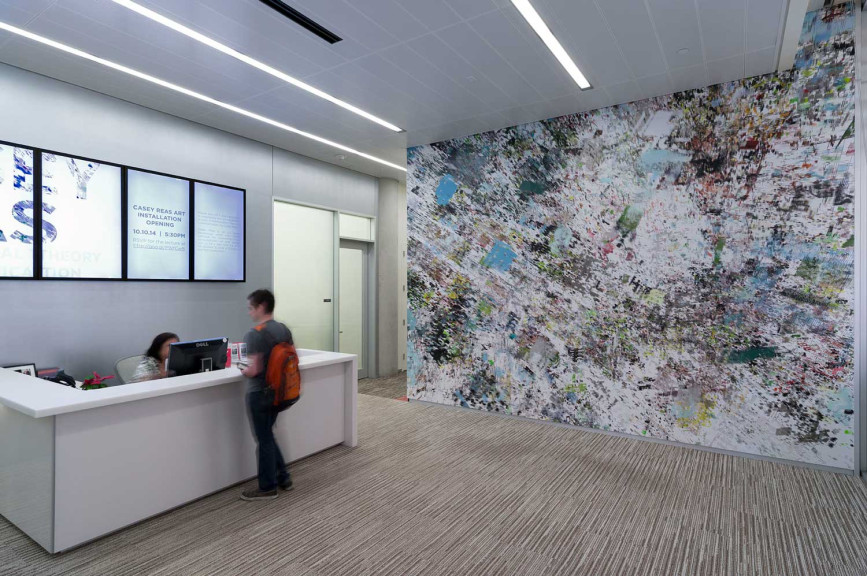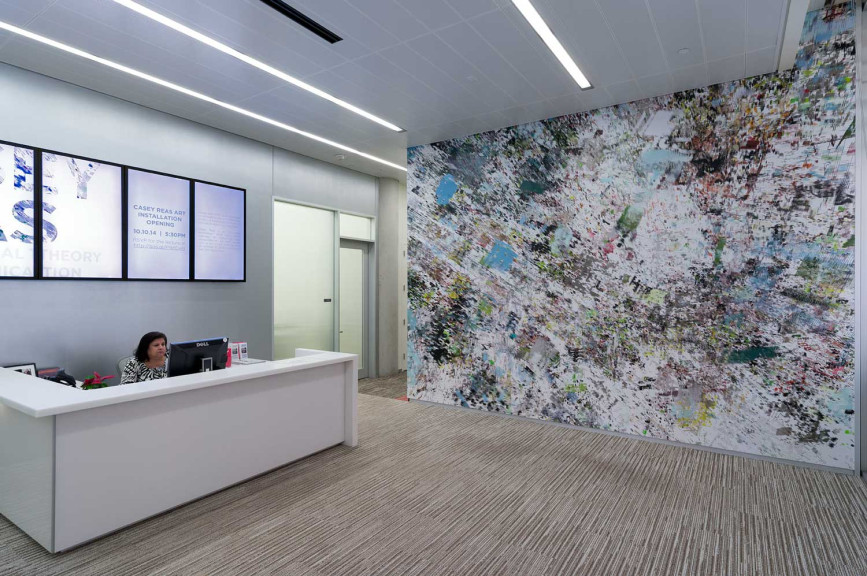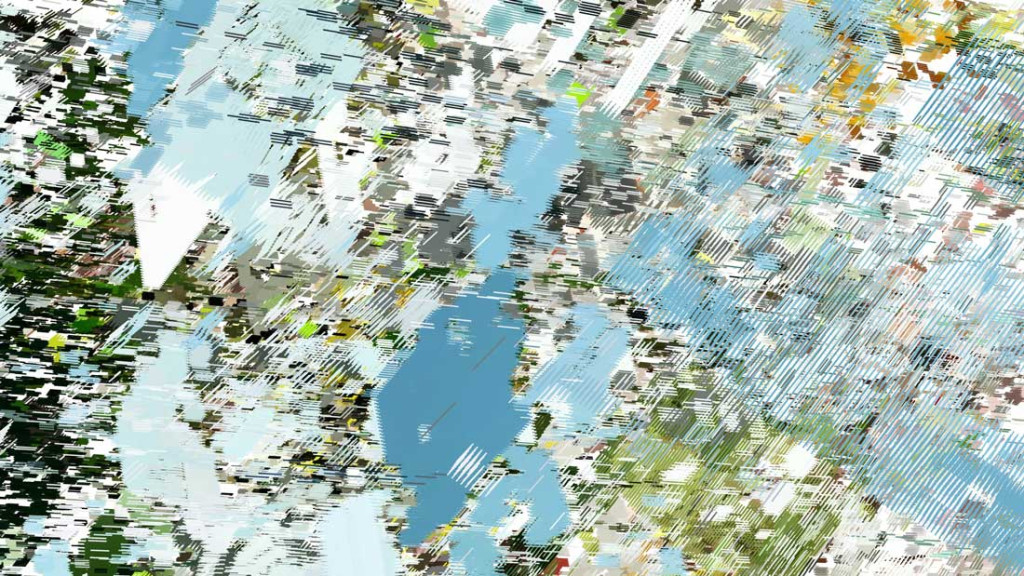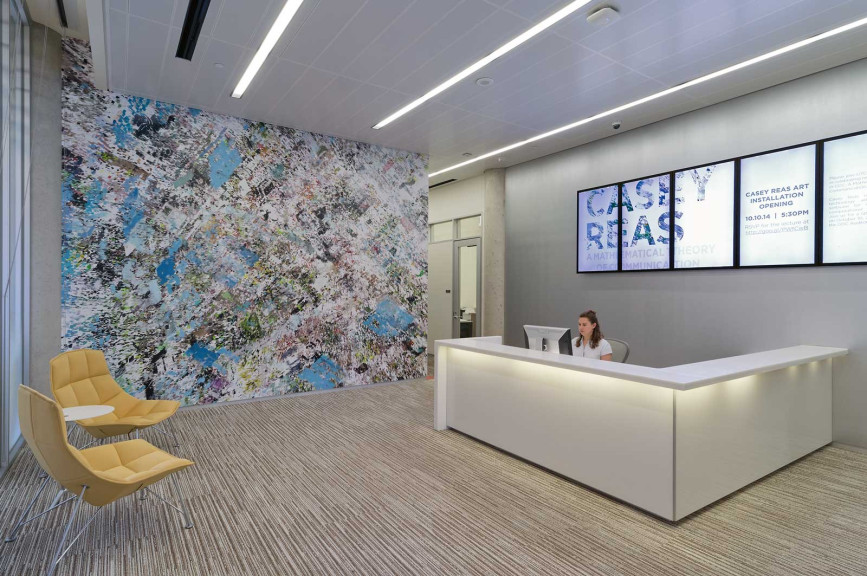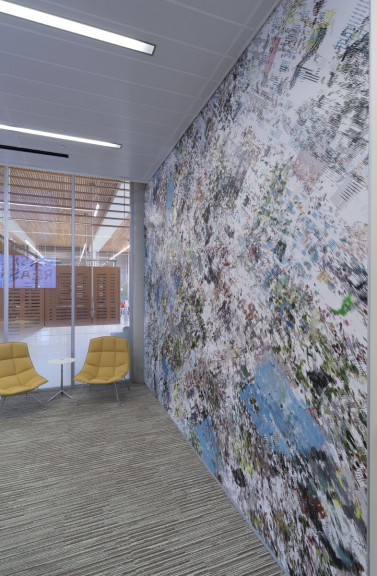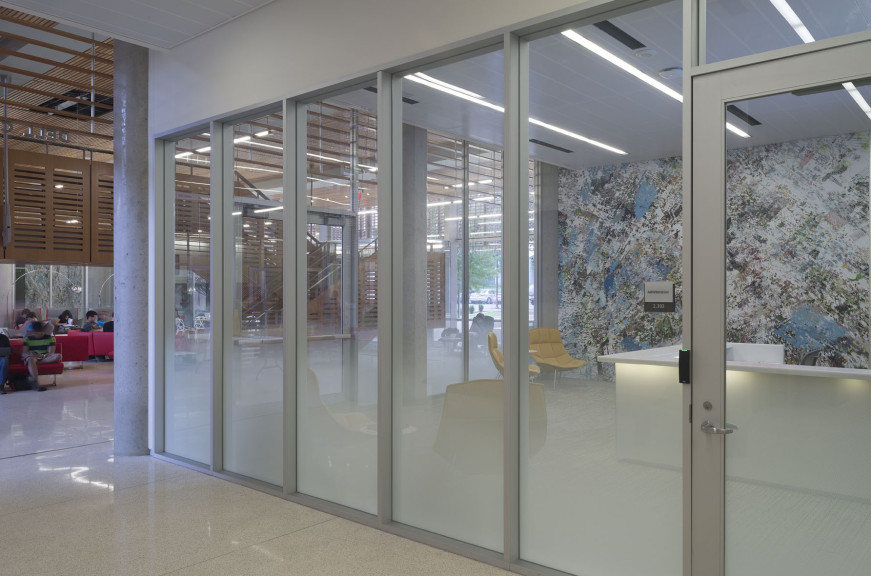A Mathematical Theory of Communication
Casey Reas
Two walls: 167 × 198 1/4 in.; 167 1/2 × 190 3/4 in.
Photography not permitted
Commission, Landmarks, The University of Texas at Austin, 2014
GPS: 30.286389, -97.736667
Casey Reas is a leading artist in the genre of software art, defining both the practice and the theoretical discourse in the field. In 2001, he partnered with fellow MIT student Ben Fry (born 1975) to initiate and create Processing, an open-source programming language and visual environment for coding. Today, artists, designers, and students around the world use Processing for visual prototyping and for programming images, animation, and interactivity.
Reas’ software art typically explores systems, specifically their emergence and underlying instructions and conditions. Instructions form the basis of all generative art, in which an autonomous system — such as a machine or computer program — creates a work of art based on rules outlined by the artist. The instruction-based nature of software art points to art-historical roots in Conceptual art. Reas explicitly references the work of Sol LeWitt, who generated works through a set of written instructions for others to interpret.
A Mathematical Theory of Communication blends Conceptual art and information science by merging aspects of both in order to create an experiential data landscape. For this commission, Reas captured television images with an antenna, then processed the images using algorithms — or “instructions” — he designed. The abstracted images were processed again, generating some forty thousand results, from which Reas chose two perspectives with converging energy. The images were inkjet printed to create the mural on two walls.
The title of this piece references a highly influential article (1948) by Claude Shannon, considered one of the founding texts of information theory. Shannon proposed that messages are transformed into a signal by a transmitter, then sent through a channel, decoded by a receiver, and finally delivered to a destination. Reas adopted the title to capture the visual and conceptual theory of communication unfolding in his art, emphasizing that as viewers, we become receivers who decode the imagery. While the title of the work suggests a technologically or scientifically driven exploration, the project itself is highly visual, conceptual, and experiential.
LEARNING AT HOME WITH LANDMARKS
Bring the Landmarks collection into your home-learning environment. Check out how you can engage with this work by browsing the learning resources featured on this page:
- View Photo Gallery - Click on the arrows on the sides of the image above to to view images of the work. Spend time on each photo and examine details carefully as if you were with the work in person.
- Play Audio Guide - Select “Play Audio Guide” in the upper right corner to hear a short audio guide about the art and gain a deeper understanding of its meaning.
- View Videos - Select “View Videos” to watch a 3-minute video with the artist and to understand their process.
- Activity Guides - Choose the activity guide below best suited for young learners in your home.
Still have questions or want to share your Learning at Home with Landmarks experience with us? Keep the conversation going by tagging Landmarks on social media.
ACTIVITY GUIDES
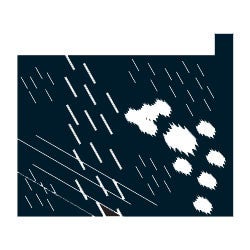
A Mathematical Theory of Communication
Casey Reas
Subject: Balance
Activity: Create a collage using colored shapes
Materials: Construction paper, markers or colored pencils, scissors, glue
Vocabulary: Composition, balance, pattern, texture
When artists create a work of art they use shapes, colors, and patterns to create a balanced composition. Casey Reas used patterns made of colors and shapes to build this work of art. The patterns are arranged in a special way so the picture seems balanced and neither side of the picture is “heavier” than the other.
How many colors do you see?
Do the colors and shapes make up patterns?
What shapes do you see?
Does the work of art look “heavier” in some areas and “lighter” in others?
Cut out shapes and arrange them across a large sheet of paper. Use markers or colored pencils to create patterns and textures connecting the shapes to create a balanced work of art.
This work of art was created on a computer using a special program built by Casey Reas. It was printed on paper and pasted to the wall.
Composition - The plan, placement, or arrangement of the shapes and colors in a work of art.
Balance - An arrangement of shapes and colors so that no part is more important than another
Pattern - A repeating line, shape, or color
Texture - The appearance of being rough or smooth
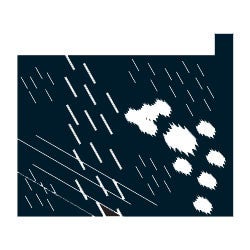
A Mathematical Theory of Communication
Casey Reas
Subject: Balance and movement
Activity: Design a patter using grid paper
Materials: Grid paper, ruler, compass, pencil, markers or colored pencils
Vocabulary: Composition, balance, movement
To create a dynamic work of art, artists incorporate movement and balance into their composition. Movement is used to help guide your eye across a dynamic work of art and balance ensures that both sides of a work of art have equal “weight”. A picture does not have to be a mirror image in order to be balanced. Casey Reas made this work of art by creating a pattern within a computer system.
How did the artist create a sense of movement across the composition?
What makes the composition balanced or unbalanced and why?
Using grid paper, a compass, and a ruler create a pattern and apply it across the entire sheet. Use lines and colors to create movement and balance.
Casey Reas created a computer program called Processing to create this piece. He inputs an image into the computer and the program rearranges the elements based on Reas’ instructions.
Composition - The plan, placement, or arrangement of the elements in a work of art
Balance - An arrangement of shapes and colors so that they have equal force
Symmetry - An arrangement of shapes and colors where both sides are exactly the same
Movement - An arrangement of shapes and colors that gives the feeling of motion and guides the viewer’s eyes around the work of art
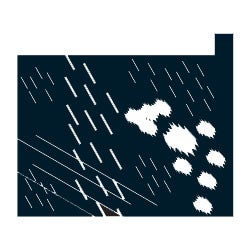
A Mathematical Theory of Communication
Casey Reas
Subject: New media art and conceptual art
Activity: Compare the work of new media artist Casey Reas with conceptual artist Sol LeWitt
Vocabulary: Software art, conceptual art, new media art
Casey Reas is one of the leading artists in the field of software art, a type of new media arts. Reas builds programs that create works of art based on a set of instructions input into a computer. This is similar to what conceptual artist Sol LeWitt was doing in the 1960s. LeWitt said “the idea becomes a machine that makes the art.” While LeWitt’s designs were intended to be followed by other people, Reas’ designs are processed by a computer.
Can you name other professions where one person's idea is executed by another person?
Who plays the more important role, the person with the idea or the person who creates it? Why?
Casey Reas is inspired by the conceptual art of Sol LeWitt. Take 10 minutes to look at both Casey Reas’ work and Sol LeWitt’s located in this building. Think about the following questions:
•How are they the same? How are they different?
•Can you imagine what LeWitt wrote as the instructions for the wall drawing? Reas inputs an image into his computer and then runs it through the program. Can you guess what the original image looked like?
•LeWitt uses a common shape through most of his work, a cube. Look closely at Reas’ piece, do you see a common shape or pattern?
•Why do you think LeWitt is one of Reas’ favorite artists?
Casey Reas created software called Processing that was used to create this piece And That’s The Way It Is by Ben Rubin, also in the Landmarks collection.
Software art - Art that is created when an artist inputs a set of instructions into a computer program, which generates the work of art
Conceptual art - Art in which an idea or concept for a work is more important that its execution
New media art - Art that is created using new technologies such as digital art, computer graphics, interactive art, video games, and computer animation
MORE INFORMATION
Over the past fifteen years Casey Reas has emerged as one of the leading artists in the field of software art. To a considerable extent, his work has defined both the practice in this field and the theoretical discourse surrounding it. While software always remains at the center of Reas’ artistic practice, his projects have also materialized as objects and installations or prints, performative events, and stage set designs. His work has been exhibited in more than one hundred solo and group exhibitions at venues around the world, including the San Francisco Museum of Modern Art and the Art Institute of Chicago. He has also received commissions from institutions such as the Whitney Museum of American Art and the New World Symphony in Miami, where Reas created a permanent video projection for the building’s nighttime façade. Reas’ work has been collected by the Victoria and Albert Museum and the Centre Georges Pompidou, among others.
Currently a professor at the University of California, Los Angeles, Reas received a bachelor’s degree from the School of Design, Architecture, Art, and Planning at the University of Cincinnati and a master’s degree in Media Arts and Sciences from the Massachusetts Institute of Technology, where he was part of the Aesthetics and Computation Group at MIT’s Media Lab. In 2001 Reas—together with fellow MIT student Ben Fry—initiated and created Processing, an open-source programming language and visual environment for coding. Bridging the gap between programming and visual arts, Processing developed from phenomenon to revolution and is now used by artists, by visual designers, and in educational institutions around the world. Processing has been groundbreaking not only as an alternative language for expanding programming space but also as an attempt to nurture programming literacy in the broader context of art and cultural production.
Reas’ software art projects typically explore systems, specifically their emergence and underlying instructions and conditions. Instructions form the basis of all generative art, in which a process—such as a computer program, machine, or other procedural invention—is set into motion and, with some degree of autonomy, creates a work of art. This generative principle is the driving force behind Reas’ work, including his Process series (ongoing since 2005), a suite of software art that explores instruction-based visuals and the emergence of systems. Possibilities for interaction between elements are outlined in code, and structures evolve through actions and movements of the elements within the given parameters. The visuals emerging from Reas’ “processes” are often seemingly organic and sometimes vaguely reminiscent of cells and tissue; they are abstractions of systems that occur in the natural world. Reas creates a new type of image space that fuses elements of drawing and experimental animation with conceptual art.
The instruction-based nature of software points to the art-historical roots of the digital medium in Dada, Fluxus, and conceptual art, all of which placed an emphasis on the variations of formal instructions and focused on concept, event, and audience participation as opposed to art as a unified object. The layer of “code” and algorithmic instructions in digital art conceptually connects to pieces by Marcel Duchamp, John Cage, and Sol LeWitt that are based on the execution of rules. In the conceptual art of the 1960s and ‘70s, idea and concept were often more central to the work than its execution. As LeWitt famously put it: “The idea becomes a machine that makes the art.” Reas has explicitly referenced the work of LeWitt and explored the relevance of conceptual art to the idea of software art. For his Process series, he writes text descriptions outlining dynamic relationships between elements and then implements them as software. The instruction for Process 4 (Software 1), for example, reads:
A rectangular surface filled with varying sizes of Element 1. Draw a line from the centers of two Elements when they are touching. Set the value of the shortest line to black and the longest to white, with varying grays between.
In his Process Compendium (2010), Reas explains:
An Element is a simple machine that is comprised of a Form and one or more Behaviors. A Process defines an environment for Elements and determines how the relationships between the Elements are visualized. For instance, Element 1 takes the form of a circle and one of its behaviors moves it along a straight line at a constant speed. Process 4 fills a surface with Element 1 and draws a line between elements while they overlap. Each Process is a short text that defines a space to explore through multiple interpretations. A Process interpretation in software is a kinetic drawing machine with a beginning but no defined end.
As part of his project titled {Software} Structures —which was commissioned by the Whitney Museum of American Art in 2004 and comprises the first three Process works, conceived in collaboration with Jared Tarbell, Robert Hodgin, and William Ngan—Reas created, with LeWitt’s permission, digital versions of some of the artist’s Wall Drawings (nos. 85, 106, and 358) by encoding LeWitt’s instructions so that they could be rendered to the screen or even respond to interaction.
Reas’ “processes” and “software structures” are presented in different forms, ranging from screens to large-scale projections, and from prints depicting the state of the process at a specific point to interactive versions that allow the audience to draw on a touch screen with their fingers, thereby triggering automated software elements that interact with each other and create additional patterns. The different manifestations of the work illustrate that the underlying “process” transcends any specific medium.
A Mathematical Theory of Communication, 2014
The project commissioned by Landmarks—a mural on two separate walls in the The Bill & Melinda Gates Computer Science Complex & Dell Computer Science Hall titled A Mathematical Theory of Communication —is both a continuation of Reas’ previous explorations and a departure from their focus. The title is borrowed from a highly influential article (1948) by Claude Shannon titled “A Mathematical Theory of Communication.” It is considered one of the founding texts in the field of information theory. Realizing the broad applicability of his theory, Shannon expanded the text, in collaboration with Warren Weaver, and published it as a book titled The Mathematical Theory of Communication in 1949. Reas used the original title of the article to capture the visual and conceptual theory of communication unfolding in his artwork. While the title of the work suggests a technologically or scientifically driven exploration, the project itself is highly visual, experiential, and subjective in nature.
Reas’ version of a mathematical theory of communication builds upon and reworks the images he presented in his exhibition ULTRACONCENTRATED at New York’s bitforms gallery in 2013. As with A Mathematical Theory of Communication, the works in that exhibition—the Signal to Noise series, in particular—focused on mediation and perception, information systems, and communication. In Signal to Noise, television content was captured from the air with an antenna and then edited and processed with software written by Reas that ran live in the gallery. Each individual piece in the series scrambled a television segment captured from a network, such as ABC, NBC, or CBS, and amplified the flickering of data, thereby creating distorted new image spaces. Signal to Noise captured signals transmitted through the electromagnetic spectrum, pushing them to the edge of legibility.
A Mathematical Theory of Communication builds on ULTRACONCENTRATED by using images from the exhibition, yet once again transforming them into new ones. In visual terms, the project occupies a space between the instruction-based emergent systems of the Process series and the more architectural quality of the scrambled flicker of image spaces in Signal To Noise. This in-between space seems to mirror the conceptual approach of the artist, who admits that he originally felt constrained by both his work’s proximity to a LeWitt wall drawing and its position in the Computer Science building. A Mathematical Theory of Communication transcends the constraints of both conceptual art and pure information science by merging aspects of both in order to create an experiential data landscape that immerses the viewer. The visuals of the project oscillate between the familiar, recognizable, and an uncertain, constantly emerging space: they still have qualities of painterly abstraction and occasionally seem to suggest a legible original source image, yet ultimately deny legibility by putting the viewer in the middle of the computer vision algorithm that transformed the original imagery. Both murals are based on the same source image yet analyze it in different ways, once again playing with uncertainty—the threshold between similarity and difference.
While many of Reas’ previous works, such as the Process series, explored the connections between early instruction-based conceptual art and the algorithmic nature of software art, A Mathematical Theory of Communication focuses on communication and information theory as another important strand of digital art’s history. Both the kinetic art and early digital art of the 1960s and ‘70s were deeply influenced by notions of cybernetics, as well as information and systems theory. In the 1940s American mathematician Norbert Wiener (1894–1964) coined the term “cybernetics”—from the Greek term kybernetes, meaning “governor” or “steersman”—for the comparative study of different communication and control systems, such as the computer and the human brain. In Cybernetics: Or, Control and Communication in the Animal and the Machine (1948), Wiener defined three central concepts, which he maintained were crucial in any organism or system—communication, control, and feedback—and postulated that the guiding principle behind biological life and organization is the information contained in messages. Claude Shannon’s investigations of the transmission of information made a major contribution to cybernetics. He famously proposed that messages are transformed into a signal by a transmitter, then send through a channel—be it a cable or band of radio frequencies—and decoded by a receiver, and finally delivered to a destination, be it a human or machine. Reas’ project reads Shannon’s original text as philosophy and theory and visually reinterprets his theory of communication and the signal: in his murals, an original source image is “encoded” into a signal through an algorithm. As viewers of Reas’ data landscape, we become receivers who decode the imagery.
A central element in Reas’ project is the uncertainty in the perception and legibility of images. Uncertainty in the delivery of a message also plays a major role in the communication theory of Shannon, who faced a major question: How does one encode a message in such a way that its transmission rate through a “noisy” channel is maximized and the error rate minimized? For Shannon, uncertainty is a twofold operation that emerges in the concepts of both noise and entropy. Shannon’s goal was to create a more efficient signal-to-noise ratio. He believed that repeating messages in order to avoid “misreadings” would only increase the potential for even more noise and, at the same time, reduce the transmission capacity of the channel. In information theory, entropy means the average amount of information contained in each received message. Entropy thereby also becomes a measure of uncertainty: Shannon posits that the greater the number of possible messages, the greater the uncertainty. In order to solve the problem he proposed to encode messages in a way that would be tailored to the transmission capacity of the channel.
Reas’ piece by no means takes a technical approach to illustrating Shannon’s concepts, but still is conceptually informed by them. In a poetic and visual way rather than mathematical one, Reas’ A Mathematical Theory of Communication explores the uncertainties of the algorithmically processed image. Entropy, as the amount of information contained in the image, and noise, as the disturbances and glitches in the transmitted image, both create uncertainties. Reas’ two murals visually amplify how these uncertainties are an essential part of the image and the way in which the viewer receives its message. His imagery communicates its message both with fidelity (as a minimal amount of noise and distortion) and entropy: on the one hand, there is fidelity in the familiar, recognizable elements; on the other, there are uncertainties created by the many possible messages that are carried by the abstract, constantly evolving imagery. A Mathematical Theory of Communication puts viewers in the middle of the data landscape, inviting them to experience algorithms and the digital medium in both its fidelity and uncertainties. While the murals create this experience on the basis of specific imagery, they raise questions about perception that ultimately apply to any work of digital (or even visual) art: how do images communicate their message and how do we decode and perceive them?
Christiane Paul is an associate professor at the School of Media Studies, The New School, and Adjunct Curator of New Media Arts at the Whitney Museum of American Art. She has organized exhibitions in countries around the world, written extensively on new media arts, and lectures internationally on art and technology.
Graham, Beryl. New Collecting: Exhibiting and Audiences After New Media Art. Farnham, Surrey, UK: Ashgate Publishing, 2014.
Knight, Christopher. “Modern Experience, Dissected 11 Ways.” Los Angeles Times, 30 September 2005.
Rawsthorn, Alice. “A Master of Image and Information.” International Herald Tribune, 10 October 2010.
Rothenberg, David. Survival of the Beautiful: Art, Science, and Evolution. London and New York: Bloomsbury Press, 2011.
Quaranta, Domenico. In Your Computer. Brescia, Italy: Link Editions, 2011.
Reas, Casey, and Ben Fry. Processing: A Programming Handbook for Visual Designers and Artists. Cambridge: MIT Press, 2007.
Reas, Casey, Chandler McWilliams, and Lust. Form+Code in Design, Art, and Architecture. New York: Princeton Architectural Press, 2010.
Reas, Casey. Process Compendium 2004–2010. Berlin: Gallery [DAM], 2010.
Reas, Casey et al. 10 PRINT CHR$(205.5+RND); : GOTO 10. Cambridge: MIT Press, 2013.
Whitelaw, Mitchell. “System Stories and Model Worlds: A Critical Approach to Generative Art.” In Readme 100: Temporary Software Art Factory, edited by Olga Goriounova, 135–54. Norderstedt: BoD, 2005.
A Mathematical Theory of Communication by Casey Reas bridges the gap between the technical world of programming and the visual realm of art and design. His project is accessible in the atrium of the Gates Dell Complex during regular building hours.
In 2013 the Chair of the Department of Computer Science, Bruce Porter, requested Landmarks assistance in acquiring art to enhance two walls in the department’s administrative and academic office suites. Landmarks identified artists whose work would complement the Sol LeWitt pieces that had been installed when the building was constructed in 2012. After reviewing a range of possibilities, Landmarks and the computer science’s project committee agreed that artist Casey Reas was the best choice for the commission.
A Mathematical Theory of Communication is composed of high-resolution digital prints on a fine art substrate proprietary to Maharam, the manufacturer and printer.
Funding for this project was provided by the Department of Computer Science. Landmarks would like to thank the department for its continued support. For their dedication and assistance, Landmarks would also like to thank:
Leadership
Andrée Bober and Landmarks
Pat Clubb and University Operations
Douglas Dempster and the College of Fine Arts
Landmarks Advisory Committee
Bruce Porter and the Department of Computer Science
William Powers and the Office of the President
Bob Rawski and the Office of Facilities Planning and Construction
David Rea and the Office of Campus Planning
Project Team
Andrée Bober, curator and director, Landmarks
Nisa Barger, project manager, Landmarks
Casey Reas, artist
Special Thanks
Lorenzo Alvisi, Department of Computer Science
Bill Butler, Pelli Clark Pelli Architects
Coburn & Company
Adam Klivans, Department of Computer Science
Matt Larson, Department of Computer Science
Maharam
Nick Nobel, external affairs, Landmarks
Christiane Paul, curatorial contributor
Steven Sacks, bitforms gallery
Patti Spencer, Department of Computer Science
Stephanie Taparauskas, development, Landmarks
Jennalie Travis, development, Landmarks
Matthew Walker, Department of Computer Science
Catherine Zinser, education, Landmarks

